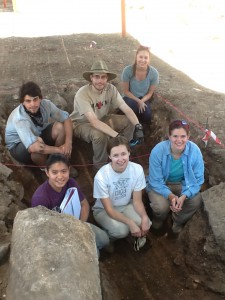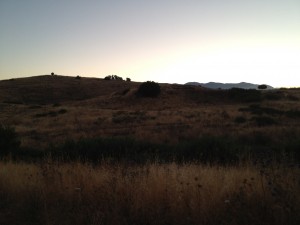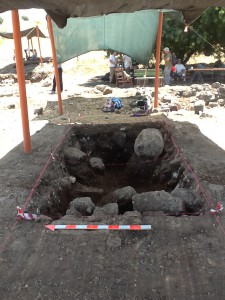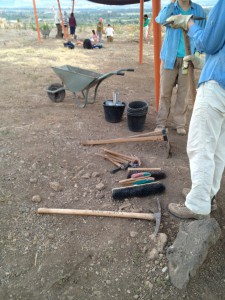Since my fellow students have already written on some of the emotional and intellectual aspects of this trip, I thought I would focus on the daily life at the dig. While our schedule was a bit irregular for the first few days, we have since settled into a routine.
On a typical weekday, we awake before dawn at 4:30AM, when our energetic field director, Prof. Rubin, knocks on our doors. In my room, my roommates listen to music videos on VH1 or MTV — some of the few English-language channels on our television — while we dress and apply copious amounts of sunscreen. Then, bleary-eyed yet still eager, we stagger into vans at 5:00AM and depart for the dig site.
The ten-minute drive to Omrit is one of my favorite parts of the day, as the sun rising above the stark Trans-Jordan mountains gradually illuminates the Hula Valley. Since the vans have difficulty on the bumpy road, we hike the last few hundred yards to the site, affording us an excellent view of the sunrise while a nearby cock crows (he’s usually a few minutes late). Along the way, we feast upon peanut butter & jelly prepared the night before.

The members of my square. Back (L-R): Brad (resident cowboy and Sasquatch aficionado), Connor (me), Maddy (rock-smasher extraordinaire). Front (L-R): Khanh (also from Williams and terrifying with a hoe), Amy (fearless square supervisor), Emily (mildly intrepid assistant square supervisor).
Upon reaching the dig site, we divide into three groups: each group includes an experienced supervisor and assistant supervisor and has been assigned a square to excavate.
My group has been ordered to begin excavation in a new region of the site where we hope to find evidence of structures near the temple. Since our square is meant to be exploratory, it actually takes the form of a 2m x 8m rectangle rather than a typical 4×4 square; despite its rectangular dimensions, we still call it a square.
Our first order of business is erecting a shelter over our hole to shelter us as the morning continues. The irregular dimensions of my square necessitate a particularly large shelter we have taken to calling affectionately “Pasha’s Tent.”
Once our shelter is erected, we collect our tools: pickaxes, hoes, patiches (miniature picks), masonry trowels, and brushes along with buckets, dustpans, and a wheelbarrow to dispose of excavated earth.
Unfortunately, the tractor happened to have passed over our square frequently during an earlier phase of the excavation and the first few inches of soil were extremely compact. However, we finally reached softer soil today and have settled into a routine: two people loosen the surface of the square with pickaxes, another two collect loose rocks and soil into buckets, and the last two empty buckets into a wheelbarrow and transport the contents to a designated dump. Patiches, trowels, and brushes are reserved for detail work.
Along the way, we keep a sharp lookout for pottery shards, pieces of glass, and architectural elements. Since Greco-Roman pottery was mass-produced and styles changed over time, fragments of rims and handles — so-called ‘indicative’ pieces — can be used to date the material found in each layer. However, this requires us to keep the surface of our square level, which can be quite a challenge when we encounter large pieces of limestone and basalt, the former often [i]spolia[/i] taken from the temple by later inhabitants of the region and the latter often used in Byzantine construction in the region.
Every hour, we have a short water break and switch positions. Then, at 8:30AM, we pause for “second breakfast,” a meal brought from the kibbutz by one of the volunteers. After that, we continue excavating until 11:30AM, when we begin cleaning our square, trimming our “bulk” – the edge of our square – and storing our tools. We usually depart shortly before noon after six hours of work. Since lunch is at 1:15PM, that leaves us just enough time to clean the pottery fragments collected the previous day.
After lunch, we are free until 4:00PM. People often use this time to nap, swim in the kibbutz pool, wander the grounds, catch up on reading, correspond with friends, or socialize. Personally, I like to spend my afternoons reading when I’m not catching up on sleep.
At 4:00PM, the squares are assigned to various projects around the dig site: enlarging existing squares, surveying the surroundings, and cleaning various excavated objects. The relative quiet of the site in the afternoon is a bit disorienting after the organized chaos of the morning. Finally, we return to the kibbutz around 6:15PM, just in time for a shower before our 7:30PM dinner. After dinner, we often attend lectures by dig members and visitors on topics like Roman-Parthian interactions during the Hasmonean period, ceramics analysis, and graduate school (several graduate students are participating in the dig in addition to professors and undergrads from Williams, Carthage, Macalester, and CUNY Queen’s College). After these lectures, which start around 8:30PM and usually end around 9:30PM or 10:00PM, my roommates and I often retire straight to our room, ready to begin again the next day.
In spite of the early rise and long hours of labor, I have greatly enjoyed the dig so far. After digging through a particularly compact layer of soil, we have found a column drum, a number of Byzantine and 13th century pottery sherds, and what may be the remains of a Byzantine wall. Each day brings with it the excitement of digging deeper, hoping to uncover further structures, and everyone is able to contribute intellectually (some more than others) as well as physically to the process. Plus, we manage to have some fun while on the job…





